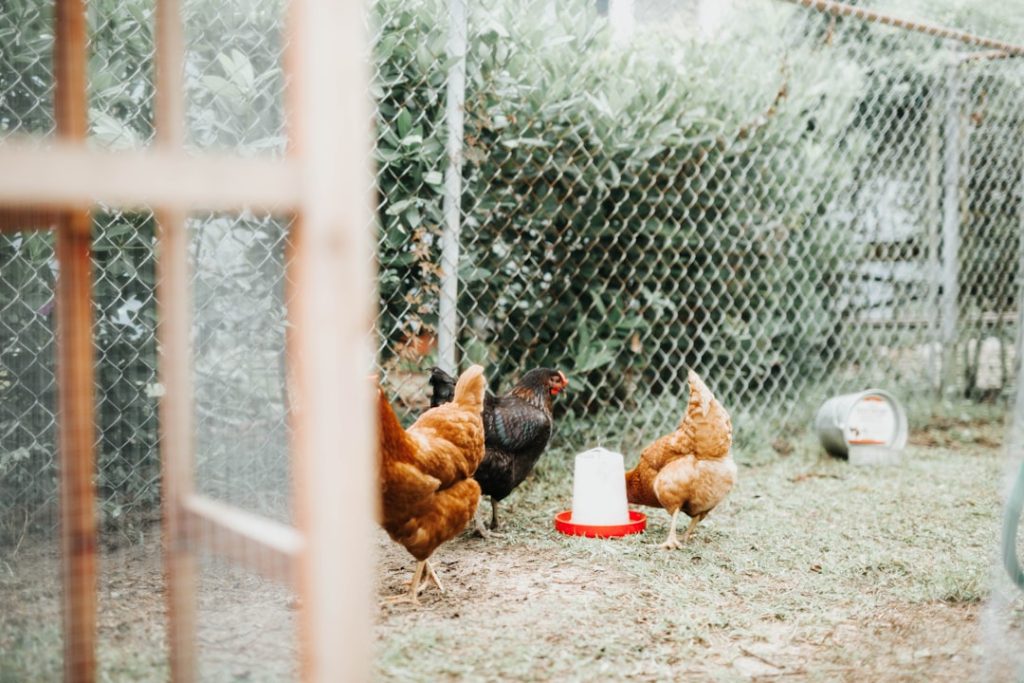When establishing a backyard chicken flock, several initial expenses must be considered. The primary investment is a suitable coop and run for the chickens, which can range from a simple DIY project to a more elaborate pre-fabricated structure, depending on budget and carpentry skills. The cost of purchasing the chickens themselves varies based on breed and age.
Additional initial expenses include feeders, waterers, bedding, and accessories such as heat lamps or nesting boxes. However, starting a backyard chicken flock can be relatively affordable for those willing to invest time and effort. Building a coop and run using recycled materials and sourcing second-hand equipment can significantly reduce initial costs.
Purchasing young chicks instead of mature hens is often more cost-effective, as chicks are generally less expensive and provide the opportunity to raise them from a young age.
Table of Contents
- 1 Housing and Coop Maintenance
- 2 Feed and Supplements
- 3 Veterinary Care
- 4 Predation and Security
- 5 Egg Incubation and Brooding
- 6 Replacement and Retirement
- 7 FAQs
- 7.1 What are the initial costs of keeping chickens?
- 7.2 What are the ongoing expenses of keeping chickens?
- 7.3 How much does chicken feed cost?
- 7.4 What are the costs of maintaining a chicken coop?
- 7.5 Are there any unexpected expenses associated with keeping chickens?
- 7.6 Are there ways to reduce the expenses of keeping chickens?
Key Takeaways
- Initial Costs:
- Initial costs for setting up a chicken coop and purchasing chickens can vary depending on the size of the coop and the number of chickens.
- Costs may include building materials, feeders, waterers, heat lamps, and the chickens themselves.
- Housing and Coop Maintenance:
- Regular cleaning and maintenance of the coop is essential for the health and well-being of the chickens.
- Coops should be predator-proof and provide adequate ventilation and space for the chickens to roost and lay eggs.
- Feed and Supplements:
- Chickens require a balanced diet of commercial feed, supplemented with kitchen scraps and occasional treats.
- Grit and calcium supplements may be necessary to support egg production and overall health.
- Veterinary Care:
- Regular check-ups and vaccinations are important for preventing common poultry diseases.
- It’s important to have a trusted veterinarian who is knowledgeable about poultry care.
- Predation and Security:
- Predators such as foxes, raccoons, and birds of prey pose a threat to chickens and their eggs.
- Secure fencing, locking coops at night, and using motion-activated lights can help deter predators.
- Egg Incubation and Brooding:
- Incubating eggs and brooding chicks require specialized equipment and careful monitoring of temperature and humidity.
- Proper brooding conditions are essential for the health and development of the chicks.
- Replacement and Retirement:
- Chickens have a limited egg-laying lifespan and will eventually need to be replaced.
- Retirement plans for older chickens should be considered, whether it’s providing a comfortable living space or humane euthanasia.
Housing and Coop Maintenance
Ongoing Maintenance Costs
Once you have established your backyard chicken flock, it is important to consider the ongoing maintenance costs associated with housing and coop upkeep. This includes regular cleaning and disinfecting of the coop and run, as well as replacing bedding and nesting materials as needed. Additionally, you may need to invest in repairs or upgrades to the coop over time, such as replacing rotted wood or reinforcing fencing to prevent predators from gaining access to your chickens.
Proactive Maintenance for Cost Savings
On the flip side, maintaining a backyard chicken coop can be a relatively low-cost endeavor if you are proactive about preventative maintenance. By regularly cleaning and inspecting the coop and run, you can identify and address any potential issues before they become major problems.
Cost-Effective Strategies
Additionally, using natural or recycled bedding materials can help reduce ongoing costs, as well as implementing predator-proofing measures such as secure latches and hardware cloth to keep your chickens safe.
Feed and Supplements

Feeding your backyard chickens is an ongoing cost that should be factored into your budget. This includes purchasing a balanced feed that meets the nutritional needs of your flock, as well as providing supplemental treats and scratch grains. Additionally, you may need to invest in calcium supplements such as oyster shell or grit to support egg production and overall health.
Conversely, there are ways to reduce the ongoing costs of feeding your backyard chickens by sourcing feed in bulk or growing your own feed ingredients such as grains or greens. Additionally, allowing your chickens access to free-range foraging can help supplement their diet with insects and vegetation, reducing the amount of commercial feed needed. It is important to strike a balance between providing a nutritious diet for your chickens while also being mindful of cost-saving opportunities.
Veterinary Care
Just like any other pet, backyard chickens may require veterinary care from time to time. This can include routine vaccinations and parasite control, as well as treatment for common ailments such as respiratory infections or injuries. It is important to budget for potential veterinary expenses when considering the overall cost of keeping a backyard chicken flock.
On the other hand, there are proactive measures you can take to minimize the need for veterinary care for your backyard chickens. This includes practicing good biosecurity to prevent the spread of disease, as well as providing a clean and safe environment for your flock. Additionally, learning how to recognize early signs of illness or injury in your chickens can help you address potential issues before they become more serious and costly.
Predation and Security
Protecting your backyard chicken flock from predators is an important consideration when it comes to ongoing costs. This may include investing in predator-proof fencing and hardware cloth, as well as implementing deterrents such as motion-activated lights or sound devices. Additionally, you may need to consider the cost of replacing lost or injured chickens due to predation.
Conversely, there are cost-effective measures you can take to protect your backyard chickens from predators. This includes using natural deterrents such as predator-safe plants or guardian animals like dogs or geese. Additionally, practicing good coop management by securely locking up your chickens at night and promptly removing any potential attractants such as spilled feed can help reduce the risk of predation.
Egg Incubation and Brooding

Initial Investment for Hatching and Raising Chicks
If you’re planning to hatch your own chicks or expand your flock, you’ll need to consider the cost of egg incubation and brooding equipment. This may involve investing in an incubator, brooder lamp, and other necessary supplies to successfully hatch and raise chicks. Additionally, you’ll need to factor in ongoing costs such as feed and bedding for the growing chicks.
Reducing Costs through Alternative Methods
On the other hand, there are ways to reduce the cost of egg incubation and brooding. You can source second-hand equipment or borrow from other chicken keepers in your community. This can help minimize the financial burden of hatching and raising chicks.
Natural Incubation and Brooding
Another option is to allow broody hens to hatch and raise chicks naturally. This approach eliminates the need for artificial incubation and brooding equipment altogether, providing a cost-effective and natural solution for chicken keepers.
Replacement and Retirement
As with any livestock, there will come a time when some of your backyard chickens will need to be replaced due to age or declining productivity. This may include the cost of purchasing new pullets or hens to maintain your flock’s egg production. Additionally, you may need to consider the cost of caring for retired chickens who are no longer laying eggs but still require food and shelter.
Conversely, there are options for reducing the cost of replacement and retirement within your backyard chicken flock. This includes rehoming retired hens to live out their golden years in a pet or sanctuary setting, as well as sourcing replacement birds from local breeders or rescues instead of purchasing from commercial hatcheries. Additionally, considering dual-purpose breeds that can provide both eggs and meat production can help maximize the value of your flock over time.
If you’re considering keeping chickens, you may be concerned about the cost of setting up a coop and nest box. According to a recent article on PoultryWizard, the expense of keeping chickens can be mitigated by building a garden chicken coop, which not only provides a safe and comfortable environment for your birds but also allows them to forage and roam freely. The article also discusses the best type of coop for chickens, offering valuable insights for those looking to start their own flock. Check out the full article here.
FAQs
What are the initial costs of keeping chickens?
The initial costs of keeping chickens include purchasing a coop, feeders, waterers, bedding, and of course, the chickens themselves. These costs can vary depending on the size and quality of the items purchased.
What are the ongoing expenses of keeping chickens?
Ongoing expenses of keeping chickens include the cost of feed, bedding, and regular maintenance of the coop and equipment. Additionally, there may be veterinary expenses for routine check-ups and potential health issues.
How much does chicken feed cost?
The cost of chicken feed can vary depending on the type and quality of the feed. On average, a 50-pound bag of chicken feed can cost between $15 to $30, depending on the brand and ingredients.
What are the costs of maintaining a chicken coop?
Maintaining a chicken coop includes the cost of bedding, cleaning supplies, and potential repairs or upgrades to the coop. These costs can vary depending on the size and condition of the coop.
Are there any unexpected expenses associated with keeping chickens?
Unexpected expenses associated with keeping chickens may include veterinary bills for unexpected health issues, predator-proofing the coop and run, and emergency repairs to the coop or equipment.
Are there ways to reduce the expenses of keeping chickens?
There are several ways to reduce the expenses of keeping chickens, such as buying feed in bulk, using DIY methods for coop maintenance, and sourcing free or low-cost materials for bedding and enrichment. Additionally, practicing good preventative health care can help reduce potential veterinary expenses.
Meet Walter, the feathered-friend fanatic of Florida! Nestled in the sunshine state, Walter struts through life with his feathered companions, clucking his way to happiness. With a coop that’s fancier than a five-star hotel, he’s the Don Juan of the chicken world. When he’s not teaching his hens to do the cha-cha, you’ll find him in a heated debate with his prized rooster, Sir Clucks-a-Lot. Walter’s poultry passion is no yolk; he’s the sunny-side-up guy you never knew you needed in your flock of friends!







